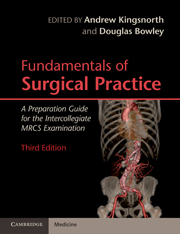Book contents
- Frontmatter
- Contents
- List of contributors
- Preface
- Section 1 Basic Sciences Relevant to Surgical Practice
- Section 2 Basic Surgical Skills
- Section 3 The Assessment and Management of the Surgical Patient
- Section 4 Perioperative Care of the Surgical Patient
- Section 5 Common Surgical Conditions
- 16 Assessment and early treatment of patients with trauma
- 17 Fundamentals of the central nervous system
- 18 Fundamentals of head and neck surgery
- 19 Fundamentals of thoracic surgery
- 20 Oesophago-gastric surgery
- 21 Fundamentals of hepatobiliary and pancreatic surgery
- 22 Fundamentals of endocrine surgery
- 23 Fundamentals of the breast
- 24 Lower gastrointestinal surgery
- 25 Fundamentals of the genitourinary system
- 26 Hernias
- 27 Fundamentals of vascular surgery
- 28 Fundamentals of orthopaedics
- 29 Fundamentals of plastic surgery
- 30 Surgical care of the paediatric patient
- 31 Fundamentals of organ transplantation
- Index
- References
24 - Lower gastrointestinal surgery
Published online by Cambridge University Press: 03 May 2011
- Frontmatter
- Contents
- List of contributors
- Preface
- Section 1 Basic Sciences Relevant to Surgical Practice
- Section 2 Basic Surgical Skills
- Section 3 The Assessment and Management of the Surgical Patient
- Section 4 Perioperative Care of the Surgical Patient
- Section 5 Common Surgical Conditions
- 16 Assessment and early treatment of patients with trauma
- 17 Fundamentals of the central nervous system
- 18 Fundamentals of head and neck surgery
- 19 Fundamentals of thoracic surgery
- 20 Oesophago-gastric surgery
- 21 Fundamentals of hepatobiliary and pancreatic surgery
- 22 Fundamentals of endocrine surgery
- 23 Fundamentals of the breast
- 24 Lower gastrointestinal surgery
- 25 Fundamentals of the genitourinary system
- 26 Hernias
- 27 Fundamentals of vascular surgery
- 28 Fundamentals of orthopaedics
- 29 Fundamentals of plastic surgery
- 30 Surgical care of the paediatric patient
- 31 Fundamentals of organ transplantation
- Index
- References
Summary
Surgical anatomy
Small bowel
The small bowel extends from the pylorus to the caecum. Disorders of the duodenum are discussed elsewhere and this chapter will be concerned with the small bowel from the duodenal–jejunal junction to the caecum. The entire small bowel is enveloped in peritoneum, the attachments or ‘root’ of which run from the ligament of Treitz to the terminal ileum. The upper two-fifths of the small bowel is jejunum and the distal portion is ileum but the transition point lacks clear demarcation. The arterial supply, innervation and venous and lymphatic drainage pass through the mesentery. The arterial supply arises from the superior mesenteric artery, which enters the mesentery over the superior border of the third part of the duodenum. The venous drainage returns to the superior mesenteric vein, joining the splenic vein to become the hepatic portal vein. The small bowel is rich in immune cells with Peyers patches in the submucosa and nodes within the mesentery subsequently draining to the cysterna chyli. Parasympathetic and sympathetic fibres are relayed through Auerbach plexus and parasympathetic continue through Meissner's submucosal plexus.
Visceral pain from the small bowel is relayed through sensory afferents running with the sympathetic nerves. Distension or colic causes pain in the paraumbilical region, reflecting the mid-gut embryological origin of the small bowel. Localized inflammatory conditions of the small bowel relay pain through parietal sensory innervations in the peritoneum of the abdominal wall.
- Type
- Chapter
- Information
- Fundamentals of Surgical PracticeA Preparation Guide for the Intercollegiate MRCS Examination, pp. 430 - 452Publisher: Cambridge University PressPrint publication year: 2011
References
- 1
- Cited by



